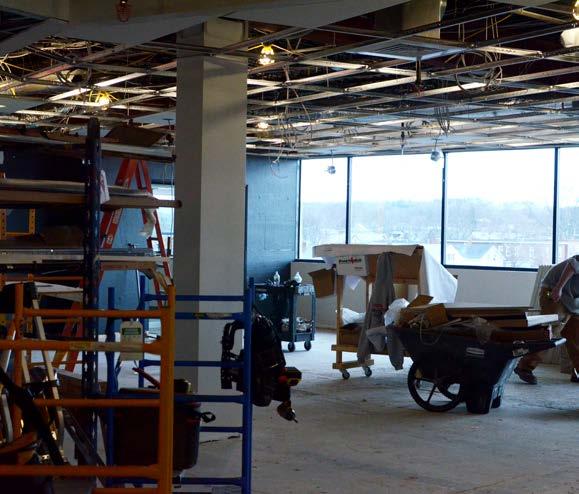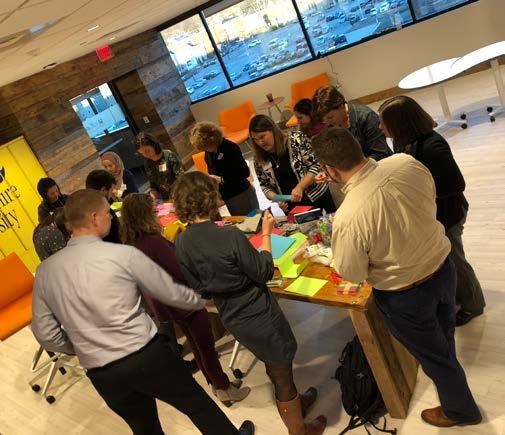INNOVATION CENTER



At Southern New Hampshire University (SNHU), everything starts and ends with our mission:

SNHU transforms the lives of learners. Our success is defined by our learners’ success. By relentlessly challenging the status quo and providing the best support in higher education, SNHU expands access to education by creating high-quality, affordable and innovative pathways to meet the unique needs of each and every learner.
We believe that education remains the greatest driver of social change. Therefore, we aspire to serve learners at an unprecedented scale, improve the quality of academic and career outcomes, and help reshape higher education for a world of uncertain and exponential change. We do this work to realize our vision: Make the world a better and more just place through higher education, one learner at a time.
Because of our unyielding and non-negotiable dedication to this vision, we are pursuing five strategic commitments:
1. Deliver a broad portfolio of high-demand credentials leading to meaningful work and purposeful lives
2. Provide the best and most personalized learner support in higher education
3. Attract, develop, empower, and retain world class talent to deliver on our mission
4. Deploy transformational technology to support next-generation learning on a global scale
5. Create the capacity and foundation on which to build the 2030 learning ecosystem
Innovation is essential to the pursuit of our mission, vision, and strategic commitments. We do not innovate for the sake of innovation; we innovate in the service of social justice. We have an opportunity and a responsibility to serve learners for whom higher education is not a guarantee — a generation of individuals whose talents our country and world cannot afford to squander. With this in mind, we seek to better understand the challenges that our future learners will face and to develop new ideas, experiment with emerging technologies, pilot new systems, and pursue partnership opportunities that will help learners successfully navigate these obstacles.
Guided by SNHU’s Board of Trustees and Leadership Council, the Innovation Center is dedicated to preparing the University for the future.
Innovation challenges us to think beyond today’s norms to cultivate the practices of tomorrow. It is a both a mindset and method through which an organization remains competitive and relevant to market demand. Innovations may take one of three forms:
Tools that enable us to scale our academic and business models
Ways to improve internal efficiencies and effectiveness
Feb 2015
Aug 2015
Changes to the way we behave and how we design and deliver programs
SNHU innovates so that we may solve our learners’ most difficult problems and imagine learning experiences for which the technology, processes, and competencies have yet to be invented. The Innovation Center serves as a resource and support system for SNHU’S leadership, faculty, and staff. By offering strategic intelligence and research and development, we help teams clarify the problems they are experiencing and develop solutions that will work now and into the future.
The Innovation Center is led by SNHU’s Chief Strategy and Innovation Officer (CSIO), who reports to and assists the Chief Executive Officer with developing, communicating, executing, and sustaining strategic projects. The CSIO manages the corporate process of innovation, change management, and strategic planning at SNHU in addition to directing all projects within the Innovation Center.

SNHU established an innovation unit to focus on strategy and innovation
Innovation unit collectively named Sandbox ColLABorative to reflect our innovation mandate
Fall 2015



SNHU Labs
Incubator
Conceptualizing New Ideas
Managing Emerging Innovations
Testing Technology Solutions
Piloting New Concepts
Our mission is to help the University identify, understand, and solve the most difficult problems our current and future learners face. We exist to transform the lives of our students – past, present, and future.
Planning began on the design and construction of a physical space for Sandbox ColLABorative to serve the University community
Apr 2016
Summer 2016
The physical space for Sandbox ColLABorative opened its doors to the SNHU community



The Sandbox team grew to include research and facilitation units
Fall 2017
Winter 2017
Sandbox team began crafting an innovation management process to shepherd future-facing strategic projects

Application of foresight methodology began which enabled re-orientation of research, facilitation, and project management for team
Jan 2018
Mar 2018
Dec 2018
Team began orienting around forces and challenges that would impact the learner of 2030 and future of work
Board of Trustees approved the formation of the Innovation Center, which houses Sandbox ColLABorative and team, to focus on future-proofing the University
Construction began on a second Sandbox ColLABorative site on campus at Webster Hall
Jan 2019
SNHU Labs established in Innovation Center
We exist to support and serve the University’s mission. To fulfill that mission, we filter every decision through a single lens: “Is this good for our learners?” Every idea, proposal, and project we take on, is pursued to help our current and future learners succeed.
We ensure transparency and trust in our process through communication and joint-ownership among all stakeholders. We embody attitudes and behaviors that support personal and professional development both inside and outside SNHU.
Innovations may come from technologies, policies, markets, and cultures – but they may also come from our colleagues. We believe everyone is an innovator. We exist to support the ideas that rise up across the University from those most familiar with the challenges our learners face.
Innovation requires an open and accessible environment that affirms ideas and encourages exploration, creativity, engagement, and change. To this end, we make all of our resources available to the University community and commit ourselves wholeheartedly to its success.
We assume that new technologies, competencies, and processes can be learned at an individual level, among teams, and as an organization. We recognize occasional failure as part of the process, and believe that every effort leads to improvement and resiliency.

We believe everyone is an innovator.
We exist to support the ideas that rise up across the University from those most familiar with the challenges our learners face.
Every project the Innovation Center takes on is subject to an evaluation process to ensure we commit to and prioritize projects that fall within our scope of services, align with the SNHU mission, and show the greatest potential for future-proofing the University. Once a project is deemed within our scope, the project enters our project lifecycle:

We use three strategic questions to evaluate every project for intake:
The project must be learner-centric, challenge the status quo, and strive to expand access to high-quality higher education.
This question will be asked during the Insight phase.
The project must prepare the University for the future. This ensures our efforts and investments remain focused on our mandate to imagine learning experiences for which the technology, processes, and systems have yet to be invented.
This question will usually be asked in the Insight or Concept Development phase.
The project must solve problems for our current and/or future learners. This ensures our efforts and investments remain focused on helping our learners navigate their most difficult challenges. We ask this question to ensure due diligence through the various prioritization and funding gates. If the project demonstrates such an opportunity, then the relevant cache of resources and funding will be released to the project team to assist it in reaching the next milestone. This question will typically be asked during the Concept Development phase.
To remain relevant in an uncertain future, the University must be agile enough to respond, adapt, and transform with the ebbs and flows of forces beyond its control. The Innovation Center was established to address these challenges. At our inception, our focus is on 10-15 years out because the technology that will be transformative at that point already exists today, but is not evenly distributed. We apply strategic foresight methodologies to help the University community understand the potential challenges and opportunities our learners will experience. We also design and run pilots to test the technologies that we see as being transformative for the learner of 2030. While we cannot predict the future, we can identify and explore the dynamics that are driving change so that we can develop strategies that help us prepare the University for any future.
SIGNALS
We identify current signals to uncover insights about the future. A signal is something happening on the fringes of society – a product, service, technology, policy, or even a personal anecdote – with the potential to scale in size, impact, and geographic distribution. We use those signals to identify the forces that will shape the future.
FUTURE FORCES
To date, we have identified five forces that will shape the landscape learners and workers will navigate in 2030:
• Human-Machine Collaboration
• Personal Economies
• Spectrum Demographics
• Shape-Shifting Organizations
• Masterminds of Reality
We do not think these are the only challenges that future learners will face. Even as we deepen our understanding of these forces and their implications, we will continue to scan social, technological, economic, ecological, and political systems for the signals and trends that can improve our understanding of the emerging future.
Armed with our understanding of signals, trends, and forces, we create a variety of plausible future scenarios and personas. These models allow the University community to explore the implications of these possible futures for our learners and the University, test hypotheses, and imagine solutions.
We run pilots through our R&D unit, SNHU Labs, to test our assumptions about technologies that exist today, some of which can be considered as signals, and their potential to transform the experience of our future learners. We explore areas relevant to the challenges and opportunities for the learners of 2030, including assessment, learning methodologies, digital credentials, and learner experience. By testing these tools today, we prepare the University to adapt and transform our teaching and learning strategies for the future.
Human-Machine Collaboration
How might A1 and machine learning challenge us to develop the skills and ethics to work in human-machine teams?
Masterminds of Reality
How might the IoT enable us to simulate everything and challenge us to integrate simulation literacyinto daily practice?
How might the rise of digital platforms challenge people to fashion their own economic opportunities?
Shape-shifting Organizations
Spectrum demographics
How might spectrum identities replace traditional demographics, enable highly personalized services, and change how people manage reputations?
How might distributed computing challenge organizations to redesign themselves to maximize human value in a world undergoing rapid change?
We host learning events throughout the University to cultivate a culture of creativity and experimentation.
We help groups navigate challenging topics and problems for the University by starting with the question: “What is the problem we are trying to solve?” – making sure to always question our assumptions and challenge the status quo.

We create the capacity and foundation for the 2030 learning ecosystem through the strategic use of foresight methodologies and product design and development, and by testing the transformative potential of existing and emerging technologies.
We manage a portfolio of new initiatives and ideas, help test their validity and feasibility, and refine them in alignment with the University’s innovation agenda.
We offer dedicated staff and physical lab spaces to help engage the University in our work and provide the foundation for cross-unit collaboration.
We actively explore new and emerging market spaces to identify, gather, manage, and distribute information about new opportunities.
We help scope, manage, and incubate strategic and future-orientated projects to ensure a disciplined approach to innovation.
We work in conjunction with other units to track and leverage disparate activities happening across the University to help drive efficiencies, mitigate against risk, and avoid redundancies.
We provide intelligence to foster a deeper understanding of the evolving higher education landscape, inform innovation projects, and contribute to decision making on transformative change initiatives.
We conduct market research and alternative analysis, and apply foresight methodologies to help the University keep pace with and get ahead of current and future trends.
We always start a new project with the question:
“What is the problem we are trying to solve?”


Every project the Innovation Center takes on is subject to an evaluation process to ensure we commit to and prioritize projects that fall within our scope of services, align with the SNHU mission, and show potential for future-proofing the University. In our innovation management process, we evaluate a proposed project based on three strategic questions during the project lifecycle. In the Insight phase, we ask:
Mission alignment is essential for moving a proposed project forward at the University. A new project must help us in our efforts to transform the lives of our learners. The project must challenge the status quo and aim to expand access to high-quality higher education to our current and future learners. If the project fits within the University mission, we then ask if the project aligns with the Innovation Center’s mandate of future-proofing the University:
A new project needs to aid in the Innovation Center’s mandate to future-proof the University by preparing for learning experiences for which the technology, processes, and systems have yet to be invented. If an innovation project idea serves SNHU’s mission and orients the University to the future, the project will continue through the Insight phase and onto Concept Development. In this phase, we seek to understand whether there is a viable central idea that is addressing a problem experienced by our learners. We ask the question:
Throughout this process, we do not subscribe exclusively or holistically to any one mindset or methodology, preferring instead to take the best of many to craft our approach. There are various milestones to be met and deliverables to be produced that affirm the project is still within our scope and serving our learners through this framework.
Early-stage exploration of promising proposals, concepts, or ideas that is not immediately tethered to solutions or business model considerations
MILESTONE(S)
• Demonstrating evidence of opportunity through a working problem statement approved by IC leadership
• Completing an idea assessment based on defined criteria, potential benefits, and feasibility
• Initial evidence-base
• Working concept paper/deck with problem statement
• Insight reports
• Legal agreements, as needed
Clarifying, imagining, and testing ideas through research and facilitated activities to define the proposed innovation and identify preliminary requirements
Highlighting strategic and operational requirements for the development of a pilot/prototype and seeking approval to move forward with pilot/prototype
Articulating a project’s value proposition, resource needs, processes, and revenue formula based upon outcome of pilot/prototype
Facilitated handover of the project to one of SNHU’s business units or new entity for full-scale deployment and implementation
• Evaluating concept and approval by IC leadership
• Identifying a working list of requirements through tools such as SWOT Analysis
• Approval of proposed solution space by both IC leadership and SNHU leadership
• Creating and testing pilot/ prototype designs
• Integrating all deliverables and project activities into an approved business plan
• Project is reviewed and transition complete
• Final concept paper/deck
• Project charter, project plan, and kickoff event
• Communications plan
• Project risk register
• Stakeholder checklist
• Project budget
• SWOT Analysis
• Pilot design documents
• Legal agreements
• Change register and request form
• SOW and MSA for consultant contracts, as needed
• Business plan
• Official project document repository
• Project assessment
• Status report
• Strategic plan
• Transition plan including transfer of knowledge, assets, and resources
• Project closeout checklist
• Project acceptance form
• Lessons learned brief